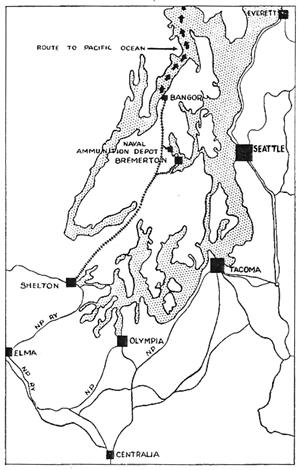On April 14, 1945, the first ammunition arrives at Navy Ammunition Depot-Bangor via the newly constructed Shelton-Bangor Railroad. Both the Bangor depot, on the eastern shore of Hood Canal northwest of Bremerton in Kitsap County, and the railroad connecting it to existing tracks at Shelton in Mason County, were constructed on a frantic schedule to meet the need for more munitions in the closing months of World War II.
New Depot Needed
As the Allies mounted a final push against Japan, existing U.S. Navy depots in the Puget Sound region at Indian Island near Port Townsend and Ostrich Bay in Bremerton could not keep up with the flow of ammunition to be sorted and stored or immediately shipped out. Bangor, on Hood Canal, was chosen as the location for the new depot partly because the waterway was deep enough to accommodate large vessels. But to be most effective it had to be connected to commercial railroad tracks. The closest ones were at Shelton, 45 miles to the south, in Mason County.
Building just the depot was challenging enough. The site was about 7,000 acres, with bogs and forests that needed to be cleared and leveled before construction could start. Structures to be built included a big two-pier wharf, administration and shop buildings, and multiple storehouses, bunkers, and barracks spread over three general areas. In the first two months of work, more than 3.25 million yards of earth were excavated. Sixty miles of road were needed, along with water, sewer, electrical, and telephone services. Barricaded areas such as the classification yard and segregation area -- also called the sorting complex -- required 4.5 miles of reinforced concrete walls 17 feet high.
"A Construction Epic"
But building the railroad was an even bigger task. Including spurs to the Puget Sound Naval Shipyard in Bremerton and Naval Ammunition Depot (NAD) Puget Sound on Ostrich Bay, plus the necessary network inside the Bangor depot, the total distance was 85 miles, and much of it was over difficult terrain. And the job needed to be accomplished in a matter of months. Surveying had begun in February 1944, but clearing of land along the proposed rail route did not start until May, and the goal was to have the project completed by that December.
A writer for the trade magazine Pacific Engineer and Builder called the project "one of the most dramatic races against time in the far west ... a war-time project that promises to become a construction epic," and said it involved "the greatest concentration of construction equipment, manpower and know-how in the history of the far west" (Edwards, "A Railroad Construction Epic, Part One").
Clearing involved cutting a 100-foot-wide swath through dense forests clogged with fallen trees. Depressions had to be filled. Soggy areas had to be carved down to solid ground and refilled. Rises had to be leveled. Only after all that had been done could tracks be laid. Boyd Smith, railroad superintendent for Sound-Kiewit Company, one of the primary contractors, summed up the overall difficulties:
"Owing to the fact that sections of line had to be built before connecting links of grading were completed, regular railroad procedure had to be abandoned. Certain equipment generally used was unobtainable and improvising became the rule and not the exception" (Smith).
Different crews worked simultaneously between Shelton to the Mason County line, and on the remaining portion through Kitsap County to Bangor. After clearing and grading, ties were placed by hand, and rails were set by crane. Spikes were hand-set, then driven by pneumatic hammers. The tracks then were covered by about six inches of tamped ballast -- crushed gravel to provide stability and drainage. Some areas needed multiple layers of ballast due to settling caused by heavy rains.
Tracklaying began in July 1944 and was completed by November. Heavy equipment in use on a single day in October included 315 crawler tractors, 106 scrapers, 31 graders, 38 shovels, and 62 dump trucks.
Delivering Ammunition
The Shelton-Bangor Railroad became operational on January 25, 1945, as an extension of Northern Pacific Railway's commercial line that ended in Shelton. In April, the navy turned over operation of the new line to the Northern Pacific. The first ammunition train reached Bangor on April 14, 1945, with 33 loaded boxcars. Following a procedure used throughout Bangor's 32-year life as an ammunition depot, the boxcars would go first to the classification area, and then to the heavily barricaded segregation area where the ammunition would be sorted and sent to its next destination, either storage or shipment. In the few months remaining in World War II, the Shelton-Bangor Railroad moved more than 6,000 loads for the navy, two thirds of them weapons and ammunition. The line was officially commissioned on August 10, 1945, shortly before the war ended.
Bangor also handled the transshipment of munitions during the Cold War and Korean War. It was especially busy during the Vietnam War, when it was the closest U.S. ammunition depot to the fighting in Southeast Asia. Bangor's role as an ammunition depot ended in 1977 when it was commissioned as Naval Submarine Base-Bangor, home to part of the nation's fleet of Trident submarines. Areas of the munitions-handling depot were abandoned. The segregation area's four buildings were demolished in 2015, and 45 boxcars still on the tracks were slated for demolition in the spring of 2018.

